Kingston SSDNow V+100 Review
by Anand Lal Shimpi on November 11, 2010 3:05 AM EST- Posted in
- Storage
- SSDs
- Kingston
- SSDNow V+100
Overall System Performance using PCMark Vantage
Next up is PCMark Vantage, another system-wide performance suite. For those of you who aren’t familiar with PCMark Vantage, it ends up being the most real-world-like hard drive test I can come up with. It runs things like application launches, file searches, web browsing, contacts searching, video playback, photo editing and other completely mundane but real-world tasks. I’ve described the benchmark in great detail before but if you’d like to read up on what it does in particular, take a look at Futuremark’s whitepaper on the benchmark; it’s not perfect, but it’s good enough to be a member of a comprehensive storage benchmark suite. Any performance impacts here would most likely be reflected in the real world.
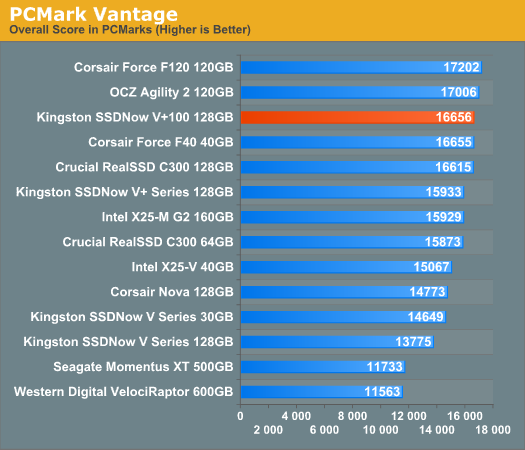
The SSDNow V+100 does very well here. Overall performance is in the top 3, higher than we’ve ever seen Kingston reach. In fact throughout the PCMark Vantage suite you'll see the SSDNow V+100 do very well. In some areas it's the fastest drive of the bunch (by a hair), while in others it's more of an average performer.
The Corsair Force F40 is the highest performing low capacity drive as you'd expect, beating out even the Intel X25-M G2. The 64GB C300 isn't too far behind however.
The memories suite includes a test involving importing pictures into Windows Photo Gallery and editing them, a fairly benign task that easily falls into the category of being very influenced by disk performance.
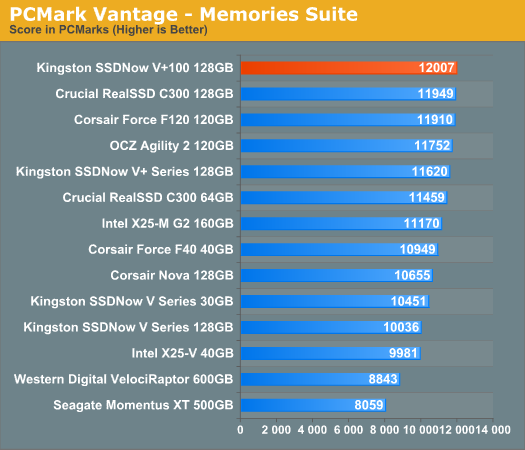
The TV and Movies tests focus on on video transcoding which is mostly CPU bound, but one of the tests involves Windows Media Center which tends to be disk bound.
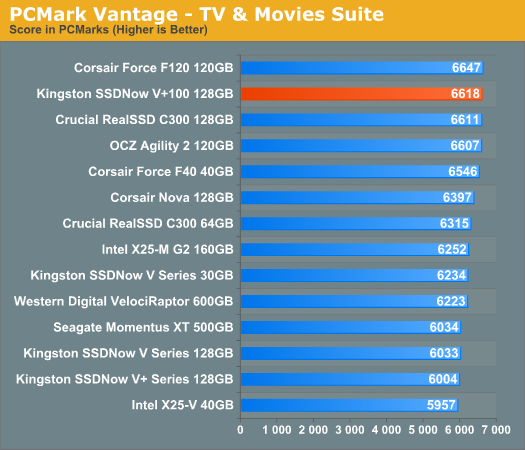
The gaming tests are very well suited to SSDs since they spend a good portion of their time focusing on reading textures and loading level data. All of the SSDs dominate here, but as you'll see later on in my gaming tests the benefits of an SSD really vary depending on the game. Take these results as a best case scenario of what can happen, not the norm.
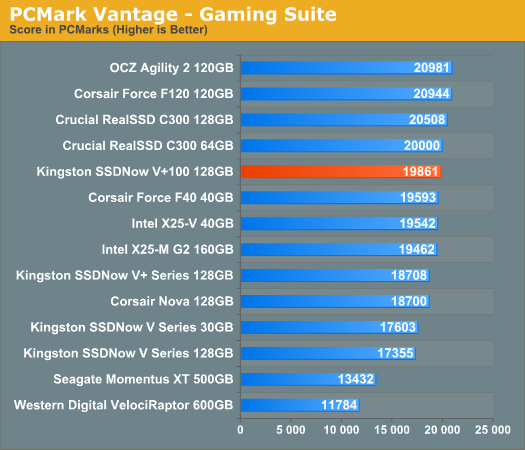
In the Music suite the main test is a multitasking scenario: the test simulates surfing the web in IE7, transcoding an audio file and adding music to Windows Media Player (the most disk intensive portion of the test).

The Communications suite is made up of two tests, both involving light multitasking. The first test simulates data encryption/decryption while running message rules in Windows Mail. The second test simulates web surfing (including opening/closing tabs) in IE7, data decryption and running Windows Defender.
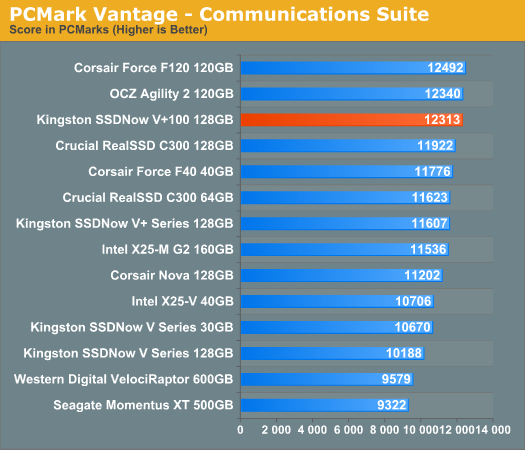
I love PCMark's Productivity test; in this test there are four tasks going on at once, searching through Windows contacts, searching through Windows Mail, browsing multiple webpages in IE7 and loading applications. This is as real world of a scenario as you get and it happens to be representative of one of the most frustrating HDD usage models - trying to do multiple things at once. There's nothing more annoying than trying to launch a simple application while you're doing other things in the background and have the load take forever.
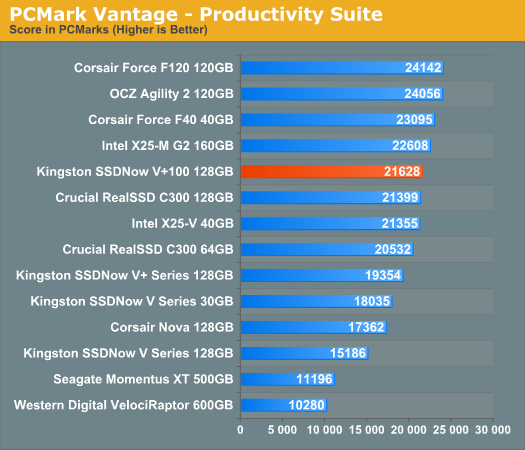
The final PCMark Vantage suite is HDD specific and this is where you'll see the biggest differences between the drives:
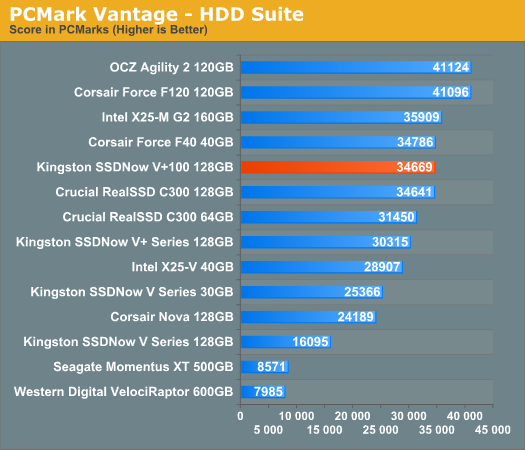
For pure I/O the SSDNow V+100 is good but not the best. Overall performance, as we've seen above looks to be pretty decent however. Let's keep going.










96 Comments
View All Comments
DanNeely - Thursday, November 11, 2010 - link
The 2xnm lifetimes will be shorter. The flash lifetime is a function of feature size, so as processes shrink lifetime will as well. At the same time, it's only likely to be a concern if you're doing very IO intensive activities. My 128GB Indilinx drive is at 96% after a year in my main desktop. At this rate I'll be nowhere near the maximum write limit when the flash dies of old age in another 4-9 years even if I keep it as my main drive the whole time which is doubtful.If scaling is linear with feature area, as the 50% drop in life-cycles from 50 to 34 nm implies, 22nm 2 level flash will last about 2500 write cycles. This still will probably be long enough not to matter. 14nm flash and beyond might not be unless they switch to SLC for consumer SSDs, and only use MLC for memory cards and thumb drives. With 10x the allowed number of write cycles SLC flash should remain good for several additional process shrinks.
OTOH that might be a moot point because the power levels needed to write flash doesn't drop with each process, and unless something changes flash is expected to hit a will in the teens because the wires on the chip won't be able to carry the load without melting.
Iketh - Thursday, November 11, 2010 - link
Anand, couldn't you just continue running your random write test 24/7 until it falls dead, or is this not feasible?Maybe it's not feasible with the Kingston drive because the random write performance is too slow? Which could bring up speculation that it's intentionally handicapped so this type of test is avoided?
Skiprudder - Thursday, November 11, 2010 - link
Hello Anand,Really interesting article as usual. I had no idea that there was such a gulf between various Sandforce controllers. There was one line however that perplexed me, "The V+ 100‘s sequential read speed is excellent, just a hair above the top drives from Intel and Crucial. There’s not much room for improvement here unless you go to a 6Gbps interface."
Why didn't you use a Sata 6 controller? I think that most of us buying boards today will be looking at Sata 6 since so many today's current SSDs clearly outstrip Sata 3, to say nothing of the upcoming 500MB/s and better drives coming down the pipeline. I'm sure you have a good reason, and I know there has been some weird controller issues with AMD I believe, but I'm very curious! Thank you.
Casper42 - Thursday, November 11, 2010 - link
Just saw this on Gizmodohttp://slickdeals.net/forums/showthread.php?t=2365...
Puts it at around $1.60/GB and if you skip past the synthetic benchmarks and look at AT Storage Bench, its a pretty formidable drive. Makes me a little sad I spent more than this on my 160 X25M G2 a while back.
BoboGO - Thursday, November 11, 2010 - link
The true cost vs. useability (usable nand) price breakdowns are as follows... I think... :)SSD Price Comparison - November 11, 2010
SSD Useability % Price $/GB of USEABLE NAND
Western Digital SiliconEdge Blue 93.13% $214.99 $1.80
Corsair Nova V128 128GB 93.13% $219.99 $1.85
Kingston SSDNow V Series 128GB 93.13% $224.99 $1.89
Corsair Force F120 120GB 87.34% $229.99 $2.06
OCZ Agility 2 120GB 87.34% $229.99 $2.06
OCZ Vertex 2 120GB 87.34% $234.99 $2.10
Crucial RealSSD C300 64GB 93.13% $134.99 $2.26
Crucial RealSSD C300 128GB 93.13% $269.99 $2.27
Kingston SSDNow V+ Series 128GB 93.13% $277.00 $2.32
Kingston SSDNow V+ 100 128GB 93.13% $278.99 $2.34
Intel X25-V 40GB 93.25% $ 94.99 $2.55
Patriot Inferno 60GB 87.34% $149.00 $2.67
Intel X25-M G2 160GB 93.13% $409.00 $2.74
Kingston SSDNow V Series 30GB 93.00% $ 82.99 $2.97
Corsair Force F40 40GB 77.71% $124.99 $3.35
SeetheSeer - Thursday, November 11, 2010 - link
Brilliant...just needs controller info added. I think I'll do some searching later tonight if I have time.Is total capacity listed in GB (10^9) or GiB(2^30)? What about usable capacity? I wish people paid more attention to this, especially in area such as this were flash storage (typically in GiB) is being used for a drive (typically in GB).
SeetheSeer - Thursday, November 11, 2010 - link
Anand,Do you think a short description of which controller each drive uses could be added to the table on page 2? It seems to me that it would be much more instructive to sort the drives based on this, rather than the often rebadged brand.
Out of Box Experience - Sunday, November 14, 2010 - link
How about this info when comparing SSD's? >1. Is it truly Plug and Play on any OS?
2. Does it have Alignment Agnostic Controllers?
3. Does it handle incompressible Data really well under XP?
Since the majority of computers still run XP, this information is the most valuable to the most people
snakyjake - Thursday, November 11, 2010 - link
There's a lot of stats for the drives, however I'm not any closer in choosing a drive.I have 3 systems:
1. Windows 7. This system is mostly lots of opened web browsers hogging memory, email, maybe a Word document, video encoding, and reference software (i.e. encyclopedia). I assume the browser is caching to the drive, same with the virtual memory and other background apps. I don't turn the machine off, so boot time is not important. For video encoding, I'd like to keep the data on a HDD since it is a lot of storage that SDD's are not affordable at storing, and it is most likely CPU bound.
2. Media Center. Want a SDD for the main drive (OS and apps), but will use a larger/slower drive for the media storage. Need something low heat. This is what I really want a SDD for.
3. Linux. Mostly emailing and web browsing. All the apps I use are cloud apps.
Obviously the fastest drive would be the one I want if money is no object. But I want to know how much faster my experience is going to be for how much more money? My goal is a snappy system and less time waiting around. I want to know what I'd sacrifice by getting a "value" drive versus the higher quality.
Also, MTBF is important. I hate losing data! Hope the drives have SMART or some other methods of warnings.
Thanks,
Jake
Out of Box Experience - Thursday, November 11, 2010 - link
If all you want to do is boot up quickly and load your apps really fast, then a sandforce drive is perfect for youIf you want to manipulate data already on the drive or copy & paste to the same drive, then you are much better off with a 7200RPM desktop drive as far as I can tell
Anyone wanting to spend their time doing actual work instead of constantly tweaking their SSD to get synthetic benchmarks that have little bearing on real world results should avoid sandforce based drives like the vertex 2
Please read my other posts in this thread for more info